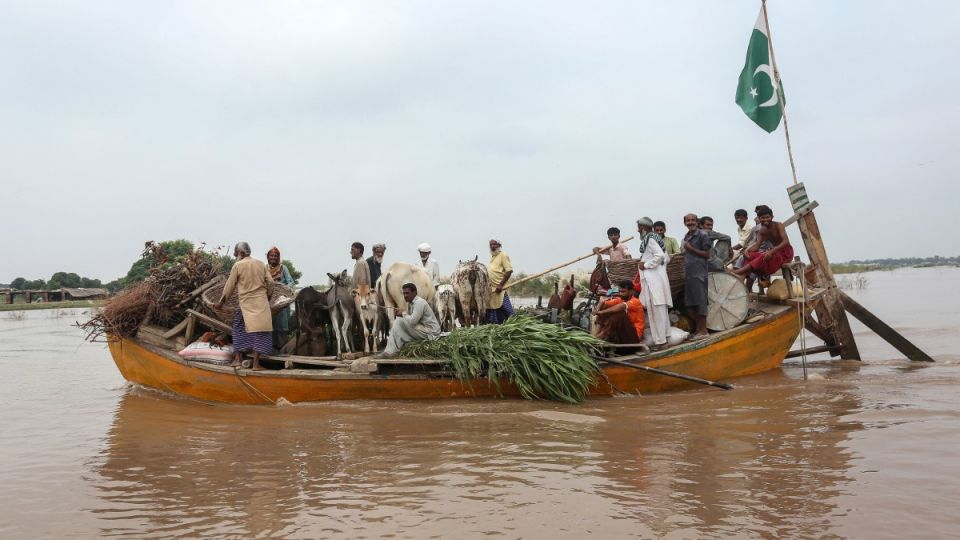September 9, 2025
ISLAMABAD – Inflation in Pakistan is no longer just about exchange rate swings, policy missteps, or global oil prices. A new driver has emerged, one that farmers and consumers alike feel with every season; climate change.
The phenomenon now being described as ‘climateflation’ is steadily pushing food costs upward, making daily survival more expensive for families across the country.
Agriculture has always been Pakistan’s backbone, feeding both the economy and millions of households. Yet, this backbone is weakening. Wheat flour, rice, sugar, and other staples have all become pricier in the past year. The reasons are no mystery to those working in the fields. Rains arrive at the wrong time, flash floods sweep away crops, and sudden heatwaves burn orchards before they can bear fruit.
In Narowal, a rice farmer explained his ordeal. “We planted on time, applied fertilisers, and irrigated as recommended during our recent field visit in the recent flood-affected belt. However, when the floods arrived, half of our paddy crop was lost in just a week. The rest is barely standing. Prices in the market are soaring, but we have nothing left to sell.”
His words capture the helplessness many growers feel when nature turns against them.
The consequences are not confined to rural Pakistan. As harvests shrink, prices in city markets climb. In Lodhran and Multan, families interviewed during research surveys reported that they had begun skipping meals, switching to substitutes, or resorting to lower-quality alternatives to manage their monthly budgets.
These choices may alleviate the financial burden in the short term, but they compromise nutritional security in the long term. Malnutrition, particularly among children and women, threatens to reverse years of progress in public health.
Farmers face an equally harsh dilemma as the costs of inputs such as diesel, fertiliser, and pesticides are climbing relentlessly. On the other hand, climate shocks wipe out the very harvests needed to recover those costs.
According to the Food and Agriculture Organisation’s (2022) report, titled “Rapid Geospatial Assessment of 2022 Flood Impact in Pakistan,” the 2022 floods devastated more than two million acres of farmland. Three years later, the floods of 2025 struck with similar force.
In Khanewal, a maize and rice grower stood beside barren land, admitting, “I borrowed to plant this season. The recent floods destroyed everything. I don’t even know how to repay the loan.”
The crisis is not limited to one crop or region. In Sindh, sugarcane and paddy farmers are watching their fields wilt under irregular rainfall. Balochistan has suffered prolonged droughts that reduced wheat and vegetable yields, while Sargodha’s orchards have been hit by scorching heat, causing fruit blossoms to fall before maturing. Livestock farmers also struggle with rising feed costs and water shortages, resulting in higher mortality rates.
Rural losses never stay confined to the villages. The shock quickly spreads to the cities. In Karachi, Lahore, and Faisalabad, families already strained by high utility bills and transportation costs now face food prices that continue to rise week after week.
For lower- and middle-income households, there is little room to adjust; every rise in flour or cooking oil prices means cutting back somewhere else.
Falling farm incomes are also pushing more people to leave their villages in search of work, adding to the pressure on urban centres. The results of this urbanisation are evident in crowded hospitals, congested roads, and housing shortages, all of which worsen when migration accelerates following poor harvests.
For policymakers, this type of inflation is unlike anything the State Bank can address. Raising interest rates won’t replace washed-out fields, nor will tighter monetary policy rebuild drowned irrigation channels.
In fact, higher interest rates often deter the investments needed to strengthen the agricultural sector. What Pakistan needs is a broader vision, one that treats food security and climate adaptation as two sides of the same coin.
Short-term measures, such as targeted subsidies, crop insurance, or food assistance, can ease the pressure on rural households. However, long-term survival will depend on larger reforms, such as restoring canal networks, building stronger flood defenses, and encouraging farmers to shift toward crop varieties that can tolerate heat, drought, or torrential rain.
Better weather forecasting and training for growers in water-saving techniques would also reduce future shocks.
These efforts will only be practical if they are grounded in local realities. Village-level organisations and farmer groups must be integral to the process, rather than being sidelined. At the same time, Pakistan will need to seek international support through climate finance, technical cooperation, and knowledge sharing to build resilience on the required scale.
Climateflation, then, is not just another economic term for policymakers to debate. It is a lived reality, one that is reshaping how families eat, how farmers work, and how the economy adjusts to a changing climate.
It serves as a warning signal that the country’s food system and household budgets are closely tied to an unstable climate. If left unaddressed, the cycle of crop failure, rising prices, and growing inequality will only deepen. Pakistan has reached a point where the debate is no longer about whether climate change influences inflation, but about how quickly we can adapt policies and institutions to mitigate its effects.
Millions of lives and livelihoods are at stake. How decisively Pakistan responds to climateflation will determine whether families can afford to eat, whether farmers can survive another season, and whether the economy can move toward stability in an era of climate variability.
The writer is affiliated with the School of Management, Jiangsu University, China, and the Department of Agribusiness and Entrepreneurship Development, MNS-University of Agriculture, Multan.


